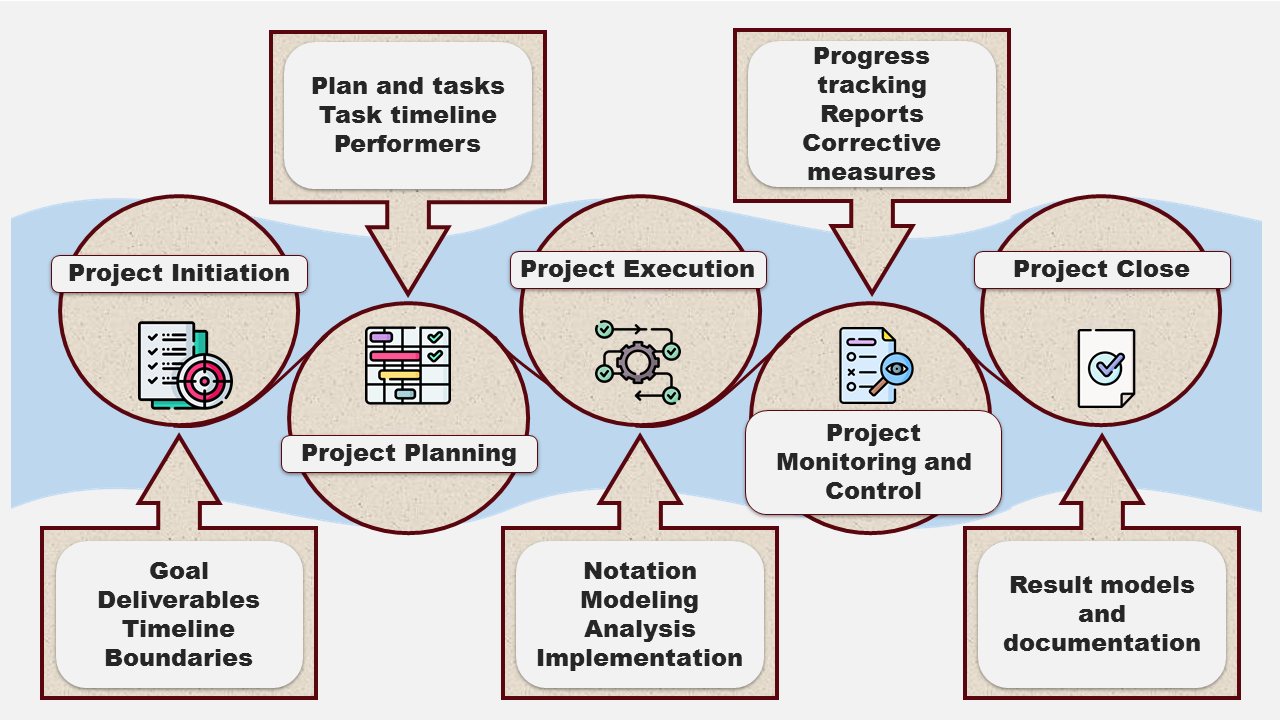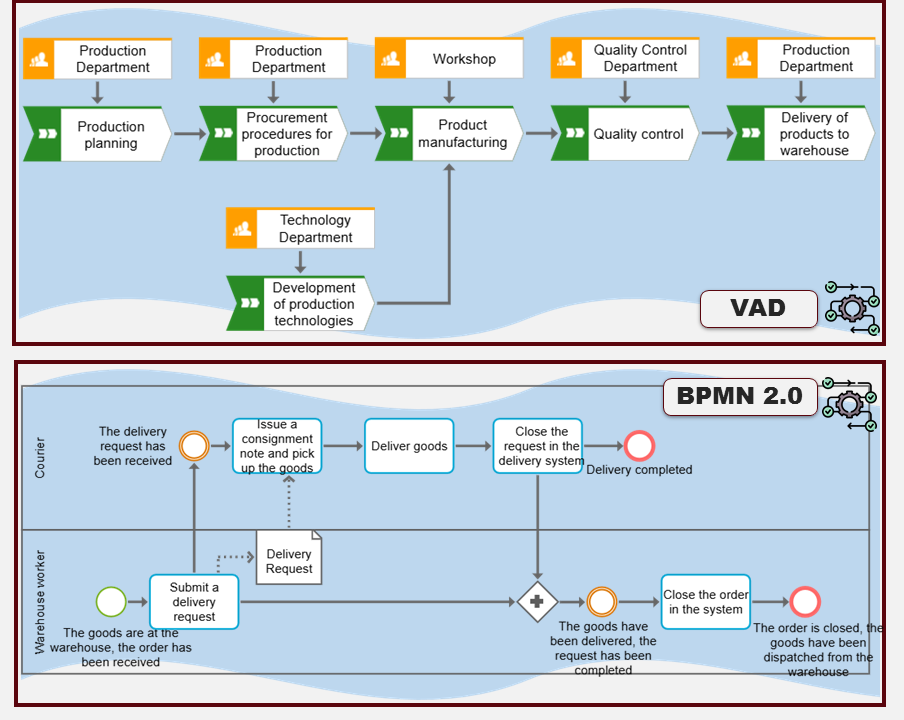Stages of business process modeling projects
Business process modeling helps identify bottlenecks, optimize task execution sequences and workflows, automate routine tasks, enhance collaboration between departments and employees, determine resource requirements, and make informed decisions based on process analysis.
The key stages of business process modeling projects (Fig. 1) include:
- Project Initiation
- Project Planning
- Project Execution
- Project Monitoring and Control
- Project Close

Figure 1. Key stages of a business process modeling project
Let's examine each stage in detail.
Project Initiation in business process modeling
At the first stage, it is necessary to define the project's goal, scope, boundaries, and expected deliverables with specific requirements.
The project's goal can be based on the company's driving factors that necessitate business process modeling. Examples of such factors include accelerating product time to market (TTM), identifying and eliminating weaknesses and inefficiencies, analyzing potential optimization opportunities, assessing compliance with standards and regulations, and designing new processes due to business growth.
The project deliverables should align with the goal and a predefined set of requirements – specifying the format of deliverables and the types of documentation to be produced. It is also advisable to define a preliminary list of model types and levels of process drill-downs, which can be refined later. Some projects may only require simple flowcharts, while others may need fully developed business process models.
A project may have multiple deliverables, but one key result will always be an up-to-date business process model. A business process model is a formalized abstract representation of a company's activities, detailing the sequence of actions with the required level of detail to achieve specific business goals.
For example, the goal of a business process modeling project may be to standardize employee workflows. The expected deliverable would be a business process model involving roles of employees, along with a set of regulations and job descriptions related to these processes. The level of detail for this project could include process descriptions down to specific employee functions corresponding to defined job roles.
The project's scope and boundaries involve identifying stakeholders, setting timelines, and determining which business areas will be covered by the project.
Project Planning in business process modeling
Based on the project's goals and expected deliverables, a plan or roadmap including specific tasks should be developed. Responsibilities for each task should be assigned, along with resource allocation and timelines for execution. The finalized project plan should be approved by the client or company management to ensure support and resource availability.
Examples of tasks in a business process modeling project plan:
- selecting modeling notation and tools;
- gathering information for modeling;
- modeling current processes ("as-is");
- analyzing current processes and identifying bottlenecks;
- designing target processes ("to-be");
- testing and piloting target processes;
- preparing final documentation, etc.
Tasks may be performed sequentially or in parallel, and each task can be broken down into subtasks. Additionally, common project management tasks such as risk management, procurement procedures, and budget approvals for a project may also be included.
Project participants may include:
- business executives;
- business analysts and project managers;
- business experts and executors of business process operations;
- process management methodologists and specialists, including external consultants;
- IT specialists and system analysts;
- auditors and controllers, etc.
The number and description of tasks as well as participants depend on the project's goals and timeline. It also depends on whether the company has already adopted a process-oriented approach and the maturity level of its business processes.
When planning the project, it is important to determine the methods for gathering information for modeling, analysis, and process design. Possible information collection methods include:
- studying existing documentation and process models, audit reports;
- conducting employee interviews, surveys, and questionnaires;
- direct observation of process execution (business process time tracking);
- collecting data from IT systems on actual business process execution, utilizing Process Mining technology.
The choice of information collection methods depends on the number of tasks, the time required for completion, the number of participants, and the overall project timeline.
Project Execution in business process modeling
Project execution involves carrying out tasks according to the project plan and timeline. Let's examine some key aspects of project execution.
Selection of modeling tools and notations
First, it is necessary to determine the required model types and their level of detail. Examples of models include value chain models, business function environment models, organizational structure models, etc.
Next, a suitable modeling notation must be selected or developed. A notation is a standardized set of rules and symbols used to create and describe models.
It is important to note that different business process modeling stages and levels of detail may require a combination of multiple notations. Common notations for business process modeling are BPMN 2.0, EPC, VAD, and others (Fig. 2).

Figure 2. Examples of business process modeling notations VAD and BPMN 2.0
In addition to notations for describing business processes, it may be necessary to develop notations for depicting the company's organizational structure, IT infrastructure, risk libraries, and other business aspects, depending on the project's goals and tasks.
It is also essential to determine the modeling tools and software that support the chosen notations and allow customization to meet the company's specific requirements. In practice, a wide range of business process modeling methods and tools are used, from whiteboards and office applications to specialized software that facilitate modeling both business processes and other company's perspectives. For example, ARIS Business Process Analysis or ARIS Process Mining.
The outcome of this task is the development of a business process modeling agreement, which formalizes all rules, requirements, and notations for modeling business processes at different levels of detail. Additionally, it may define guidelines for other model types, such as organizational structure diagrams, system libraries and lists, etc.
Business Process modeling
As part of this stage, responsible personnel engage in describing business processes. Business process modeling may include both describing existing processes ("as-is") and designing target processes ("to-be"), depending on the project's goals and requirements.
To model business processes, responsible employees gather process information through participant surveys, interviews, document analysis, brainstorming sessions, meetings, IT system data extraction, and using Process Mining technology. Then, following the guidelines in the business process modeling agreement, employees manually or automatically describe business processes and create a set of models.
This task often requires significant amount of time and effort. If the project involves designing new business processes or implementing process management from scratch, companies may face challenges such as a lack of expertise and uncertainty regarding the levels and boundaries of process descriptions. To accelerate this stage, it is recommended to use standard process databases, frameworks, and reference models as starting points for developing customized business process models, such as APQC PCF, eTOM, SCOR, ITSM, and others.
Project Monitoring and Control in business process modeling
The monitoring and control stage usually occurs simultaneously with other project stages and ensures that project activities align with the initial goals, contributing to achieving the desired results within the required timeline.
Key aspects of monitoring and control in a business process modeling project include:
- Progress tracking – monitoring the execution of tasks, identifying potential delays or issues, and developing corrective measures.
- Quality control – ensuring that the created business process models meet project requirements.
- Conflict resolution – addressing disagreements or conflicts among project participants and facilitating effective collaboration.
- Reporting and results analysis – preparing reports on project progress, analyzing achieved results, and developing recommendations for project improvement.
Project Close in business process modeling
This stage involves the formal closure of all project tasks, preparation of final reports, and evaluation of whether the project goals and expected deliverables have been achieved.
As part of this stage, all necessary documentation outlined in the project deliverables must be prepared, for example, regulations and documentation describing the developed models, reports with recommendations for process optimization, user manuals and instructions for business process management systems.
Additionally, it may be necessary to present project results to management and stakeholders, as well as gather feedback from project participants.
If required, employee training on new business processes and systems may be conducted after completion of the project, especially if training was not initially included in the project scope.
Conclusion
Most business process modeling projects follow standard project management stages. While the specific goals, deliverables, and tasks are defined by the business stakeholders, such projects generally enhance company efficiency, reduce costs, improve service quality, and strengthen collaboration between departments and employees.
Furthermore, business process modeling project results can be leveraged in other initiatives, such as process automation, business digitalization, company reorganization, and more. Thus, business process modeling is an integral part of the company's overall project portfolio.
If you have any questions, please, contact us by the contact form or at info@dainovaro.com and we provide you with more information.

 +40 (746) 44 97 97
+40 (746) 44 97 97
 info@dainovaro.com
info@dainovaro.com

